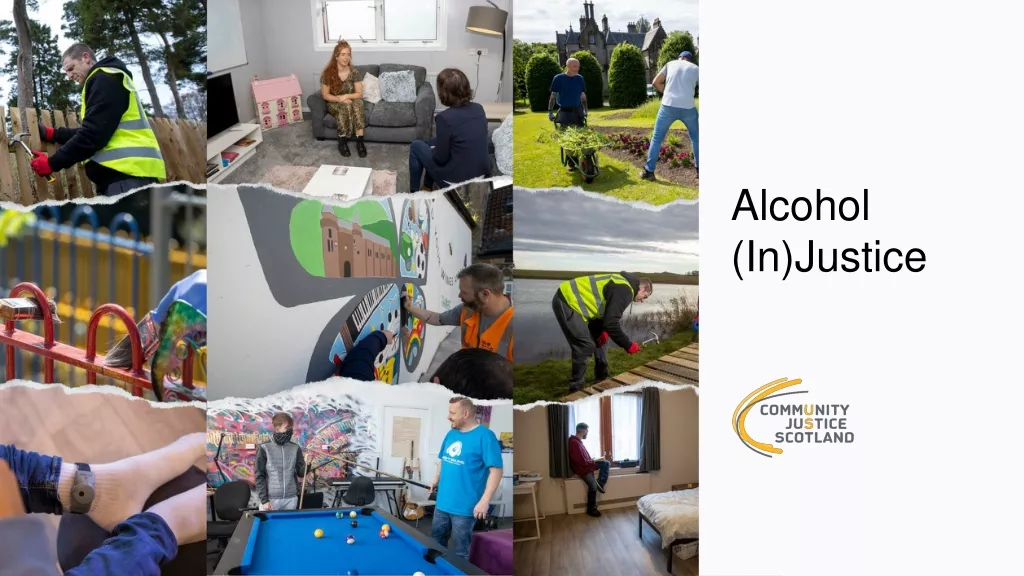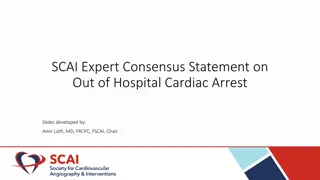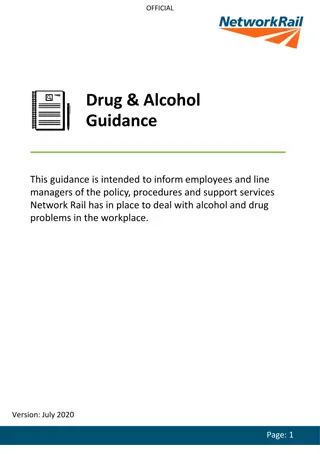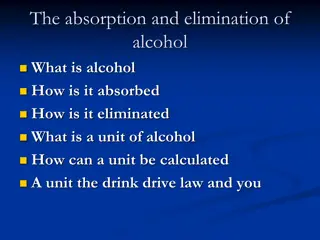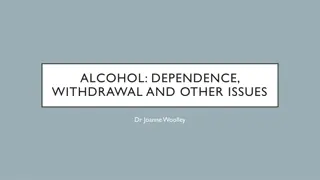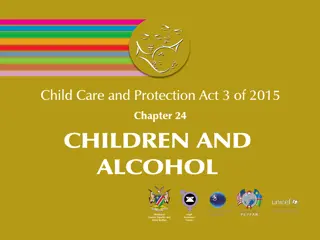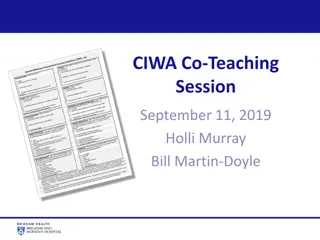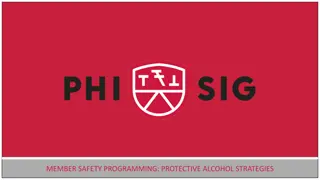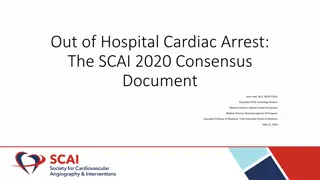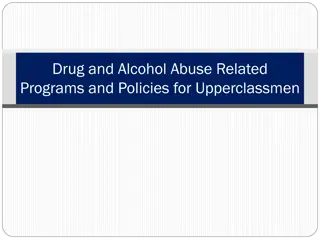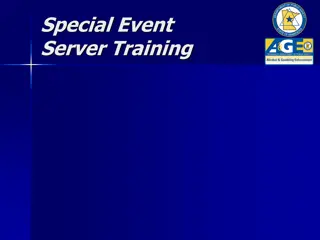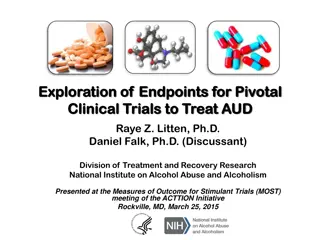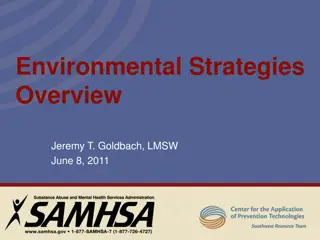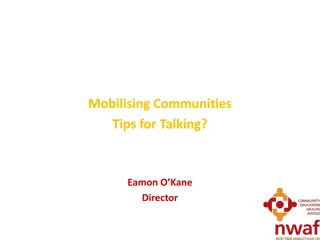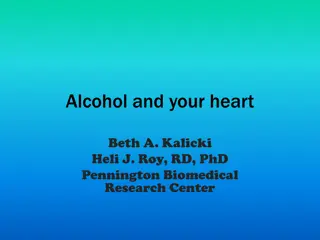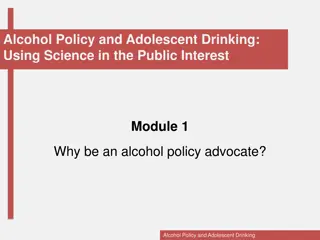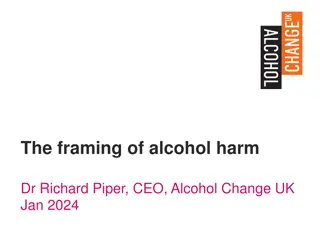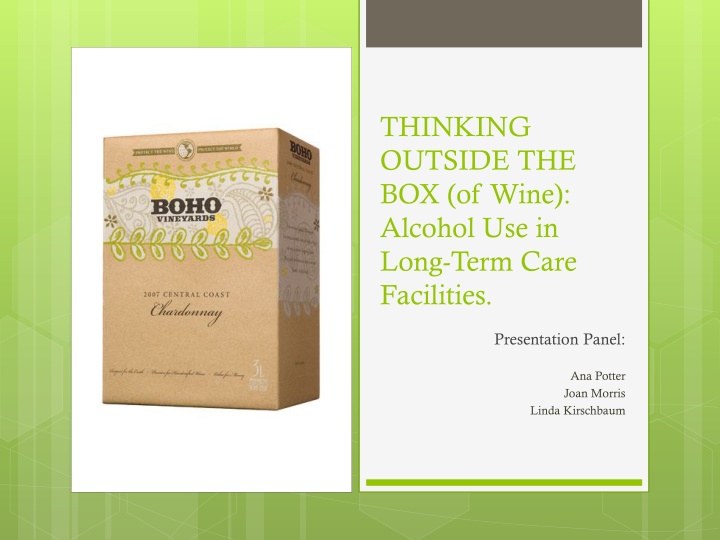
Alcohol Use in Long-Term Care Facilities: Insights and Resident Rights
Discover the complexities of alcohol use in long-term care facilities, including resident rights, risk considerations, care planning, and problem-solving strategies. Learn about resident's bill of rights and explore key principles for providing safe and homelike environments in nursing homes.
Download Presentation

Please find below an Image/Link to download the presentation.
The content on the website is provided AS IS for your information and personal use only. It may not be sold, licensed, or shared on other websites without obtaining consent from the author. If you encounter any issues during the download, it is possible that the publisher has removed the file from their server.
You are allowed to download the files provided on this website for personal or commercial use, subject to the condition that they are used lawfully. All files are the property of their respective owners.
The content on the website is provided AS IS for your information and personal use only. It may not be sold, licensed, or shared on other websites without obtaining consent from the author.
E N D
Presentation Transcript
THINKING OUTSIDE THE BOX (of Wine): Alcohol Use in Long-Term Care Facilities. Presentation Panel: Ana Potter Joan Morris Linda Kirschbaum
Why do people drink alcohol? Lifestyle Choice Memory of Special Time Culture Mental Health Concerns
Consumption of alcohol in long- term care facilities. Today s presentation will provide you with information about: Resident rights surrounding resident alcohol use; Risk considerations related to alcohol use; Using the evaluation and care plan process to drive solutions with alcohol-related challenges; Use of root-cause analysis principles to problem solve.
Residents Bill of Rights Residential and Assisted Living Facilities Residents have the right: (b) to be given informed choice and opportunity to select or refuse service and to accept responsibility for the consequences; (e) to exercise individual rights that do not infringe upon the rights or safety of others;
Bill of Rights Continued Residential and Assisted Living Facilities (n) to be encouraged and assisted to exercise rights as a citizen; (r) to have a safe and homelike environment. (OAR 411-054-0027)
Bill of Rights for Nursing Facilities Nursing Homes (1) Be encouraged and assisted while in the facility to exercise rights as a citizen or resident of Oregon and of the U.S.;
Bill of Rights Continued Nursing Homes (4) The facility staff must encourage the resident to exercise the right to make his/her own decisions and fully participate in care and care planning unless the resident has been found legally incapable of doing so.
More on Bill of Rights Nursing Homes (5) Refuse any medication, treatment, care unless found legally incapable of doing so.
PCC Continuum Person Directed Practices (Begins somewhere between Consideration of the Person and Person s Choice) Staff Directed Consideration of Individual Individual Choice Individual Control Person Directed (agency scheduled routines/staffing dictate care provision) (Individual has primacy -- determines own schedules, activities, meals, and caregivers) (Seek person s input and tailor some aspects) (Offers choices of food, waking, bathing etc.) (have right of refusal and right to take risks) Degree of Person-Directedness Developed by the Lewin Group www.theceal.org for PCC in Assisted Living: An informational Guide
CMS and Culture Change Suggests that facilities establish clear guidelines that define an elder s right to make an unpopular or ill-advised decision in view of all available information about the impact of the decision. Their recommended course of action when dealing with these types of situation is that All decisions default to the person.
Residents have the same right to drink alcohol as you do.
Framework for balancing the pieces Obtaining a complete life history Systematic, Accurate Evaluations/Assessments Individualized, Person-Centered Service Plans Mechanisms for Promoting Choice and Informing about Risk System for Monitoring Evaluating Outcomes Managing Expectations Measuring Satisfaction Communication, Communication
Communication is Key Strategies Review P&P s Translate policies into marketing, disclosure and admission documents Review preprinted physician orders Be specific in resident handbooks Establishing mutual expectations Talk about it! Marketing materials Disclosure and admission documents Community rules, guideline, codes of conduct
It pays to boil down your strategy to one simple promise, then go whole hog in delivering that promise. David Ogilvy We are here to help a person have a life, their life, in a setting where we : o are alert to risks, o make recommendations to help them stay well, and o take action based on plans they help us develop.
Meet Mr. John Johnson JJ Retired dentist, age 85 Married to the love of his life for 60 years Traveled the world together Widowed one year ago Kids live out of area Plays poker with good ole boys and enjoys beer & wine JJ is very healthy, walks daily, alert and oriented, JJ has moderately high BP controlled by medication and has severe allergies in spring and summer.
Fiction/Fact/Action Fiction: In order for a resident to drink alcohol, they must have a doctor s order. Fact: Resident s do not need a doctor s order for them to drink alcohol. Action: Facility needs to assess and care plan regarding JJ s alcohol use.
What is important to know Initial inquiry and evaluations should address lifestyle and alcohol preferences, history. NIAAA recommends alcohol consumption for adults 65+: 1 standard drink/day or 7 standard drinks per week not to exceed more than 3 drinks on one occasion. Risks Falls Drug/Alcohol Interactions Depression High Blood Pressure Behaviors Benefits Enjoyment and Quality of Life Can Stimulate Appetite Support Lifestyle (PCC)
Assessment & Service Planning Assessment, Service Planning, and Monitoring are core functions of successful resident services and satisfied customers. Systems need to be fine tuned to assure evaluations, assessments, and service plans are comprehensive and current. Create and review them as an interdisciplinary team. Easily understood by all.
Successful, Person-Centered Operations START Ask what does the resident want? Accountability Quality improvement tools to assure systems work. Train and in-service staff (routinely) Document your process and actions. Put high risk residents on high alert monitoring systems Assess /Evaluate Lifestyle, drinking patterns, diagnosis, medications, depression, other. Never jump to an answer . What is the need? Why? Who has information? Action Plan Create a CP/SP to support the resident s preferences, choices. Implement that Plan & Monitor Carry out the services/plan. What do staff need to monitor ? Apply Critical Thinking and Root Cause Analysis Risk to Action Ratio The higher the risk, the more creative you must be.
Get the Picture ! Get the Plan ! Resident Evaluation Service Plan Preferences Health Issues Medication Lifestyle Risk Factors Capabilities
Avoidable event/decline in health Avoidable means the community failed: To recognize risk factors and/or changes in the resident s condition And To take reasonable measures to assist the resident in obtaining needed services.
Example of JJs Care Plan Resident Need Reason for service When and how often will service be provided? How will it be provided? Who will provide the service? JJ enjoys poker with friends. He serves Coors Light & Chips. A life-long enrichment activity. Every Tuesday at 6 pm after dinner in game room. JJ organizes the game with his friends. He needs staff to help him bring beer & chips to game room. Staff will assist guests to game room and bring beer and chips from JJ s room. On Tuesday poker nights JJ needs his allergy medication withheld. Avoid interaction with beer JJ enjoys at his poker games. Once a week on Tuesday. CMA will review and follow MAR. Licensed staff will review MAR and physician order monthly to assure documentation supports holding the medication.
Meet Mike Jones Age is 74 years and a retired cattle rancher. A veteran of the Vietnam War. Divorcee from two marriages. Likes to drink Jack Daniels to excess. Mike often falls after he s been drinking.
Mikes Care Plan Failed Don t drink to intoxication. Press call light when need assistance to keep from falling. Mike continued to drink excessively, and community issued move-out notice.
Fiction/Fact/Action Fiction: You must issue a move-out notice to a resident who gets drunk and has falls because the resident is a danger to self. Fact: Drunkenness is not a valid reason to issue a move-out notice. Action: The facility needs to evaluate the issues and look at root cause analysis
Is a Move-out Notice Appropriate? There are two types of move-out notices for Residential and Assisted Living Facilities: 30 Day Move-Out Notice This is the default notice Less than 30 Day Move-Out Notice Can only be issued for one of two reasons: Resident left the facility to receive urgent medical or psychiatric care and facility can no longer meet needs, or Resident or other residents health and safety is in jeopardy and undue delay increases the risk.
Move-out Requirements: Mike s Drinking What interventions have been done after discovery of the situation to try and resolve the issue? Can facility issue Move-Out Notice?
Evaluate Situation What does Mike want? Assess Accountability Mike s Action Plan Implement/Monitor Interventions and Risks
Mikes New Care Plan A Resolution: Resident to have up to two shots of Jack Daniels per day, in the late afternoon, provided by a Med Aide. The med cart was draped and set up to resemble a portable bar. On it were a very nice glass (with ice), shot glass and bottle of Jack Daniels. The MA would come to the residents room and pour one shot, remove the drape and wipe down the top of the med cart/bar with a wet towel and chat the resident up a bit. If the resident requested a second shot, the same routine was followed by the MA. This was charted in the MAR for tracking purposes and for updating the FNP. It was reported on 2/20/23, the intervention continues to be successful and usually only one shot is requested.
Meet Rose Wilson Married her high school sweetheart after high school and was married for 35 years. Husband died in a car crash. Has 3 children, 14 grandchildren, and 1 great- grandchild on the way. After death of her husband, she completed nursing school and is a retired RN. Rose lives in an assisted living facility. History of depression.
Risk : Responsibility ~ The Escalating Line High Risk Moderate Risk Staff Action in Response to Need Basic Need Offer Routine Planning Encourage More Problem Solving Motivate Explaining Consequences Additional Resources
Evaluate Situation What does Rose want? Assess Accountability Rose s Action Plan Monitor Interventions and Risks
Managed Risk 411-054-0036 Used when... Used when... Harm is likely Harm is substantial Parties disagree about service plan What it s not... What it s not... A contract A waiver of liability A legal defense tool
Negotiated/Managed Risk Agreements Formal Process Social Ethics Communication Explain cause of concern Describe probable negative outcome Describe what resident wants List alternatives to minimize risk Describe what facility and others will do Describe final agreement Clarification Resident-centered Consensus
Valid Managed Risk Agreement A resident s preference takes precedence over family members. Invalid if resident cannot understand consequences. Reviewed at least quarterly. More often as situation dictates.
Interventions attempted: Discussed situation with resident/family/Dr. Additional training for staff Care plan/Service plan modification Managed Risk
Move-out Requirements: Rose s drinking and aggression What interventions have been done after discovery of the situation to try and resolve the issue? Issue Move-Out Notice Documentation: have all interventions been documented?
Alcohol use in a nutshell: Resident s right to drink. Facility s responsibility to provide a safe environment.
What We Know... Yes, older adults drink...Person-Centered Care. Understand the why of the behavior or need. What are three specific ideas/tools you heard today? QUESTIONS? THANK YOU!!

